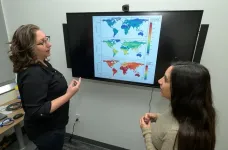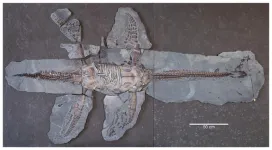(Press-News.org) BOSTON - March 31, 2025 - A memory is not a straight line from one point to another, even if we sometimes think of them like linear stories. This key insight that cognitive neuroscientists have known for many years is now guiding a new type of research—to explore not only how memories evolve over time but also how they can be strengthened or changed. Assisting researchers with this new exploration is a powerful tool: smartphones.
“Smartphones are an incredible tool for understanding patterns of feelings, behavior, and experiences in daily life, and how different types of everyday events stay with us in memory,” says Elizabeth Goldfarb of Yale University, who is chairing a session at the annual meeting of the Cognitive Neuroscience Society (CNS) about the use of smartphones in capturing naturalistic data about memory. “Real experiences have so much more salience and self-relevance than anything I can generate in the lab, and being able to quantify how people remember those events is very exciting.”
Researchers will be sharing new smartphone-based studies that suggest how a range of actions people take—from trying something new, to replaying memories before sleep, to feeling positive emotions—can help them build stronger and more detailed memories. “These talks examine both how researchers can use these data to capture how factors like emotion, novelty, and dreams transform memories, and suggest ways that people can strengthen their own memories,” Goldfarb says.
Memory replay and sleep
Morgan Barense’s current work using smartphones to capture real-time data on memory, sleep, and dreams was inspired by a serendipitous discovery in a study that wasn’t designed to look at sleep and memory at all. “We found that the timing of when someone first reviews material relative to sleep had an enormous effect on how well they later remembered it,” says Barense of the University of Toronto, who will be presenting new work at the CNS meeting. “The effect was so striking that I initially didn’t believe it. That discovery made me realize that sleep is something all memory scientists should be paying close attention to.”
Now working on studies designed by graduate student Nelly Matorina, Barense and her team are investigating a fundamental question using a smartphone app they developed that is called HippoCamera: How does a single night of sleep influence our memory for the events that occurred the day before? For example, if you dream about a dinner party from the night before, does that influence your memory for that event?
Using HippoCamera, participants recorded two events per day—one in the morning and one in the evening—over two weeks. The researchers then tested their memories after 12-hour delays that either included a night of sleep or a day spent awake. Their pre-press results showed that “memories following sleep were more vivid, felt temporally closer, and were easier to recall, suggesting that a single night of sleep helps preserve the richness of autobiographical memory,” Barense says.
The researchers also asked participants to record their dreams upon waking and indicate whether they were related to events captured with HippoCamera the previous evening. “Interestingly, memories that were dreamt about were also rated as feeling temporally closer and were more likely to be recalled from a first-person perspective,” she says.
In addition to these short-term effects, the team tested the same memories one year later to ask how they changed over time, including the connection to the memories’ locations. “Our pattern of results suggests that the link between an event and its location may initially weaken after a night’s sleep to allow for memory reorganization, but over the long term, a year later, our memory is strongly connected to where it took place,” Matorina says.
“Real-world data collection introduces variability that is difficult to control, and tracking sleep and memory over time requires careful methodological design,” Barense says. “However, these challenges are also what make smartphone-based research so promising—it allows us to move beyond artificial settings and study memory as it naturally unfolds in daily life.” By illuminating the crucial role of sleep and dreaming in memory, Barense and her team hope to gain windows into memory plasticity—better understanding the connection between sleep and our waking experiences and laying the groundwork for new ways to boost memory.
In future work, in collaboration with Ken Paller and his lab at Northwestern University, her team will investigate if it is possible to enhance real-world memory retention during sleep. They will be integrating HippoCamera with at-home targeted memory reactivation, which works by reintroducing memory-related cues—such as sounds associated with an event—during specific sleep stages. “While our previous work has shown that HippoCamera strengthens autobiographical memory in older adults, we believe that incorporating sleep-based memory reactivation will further amplify its benefits,” Barense says.
Memory vividness and novelty
Lila Davachi’s smartphone-based work on memory was motivated by the cognitive and emotional impacts of the pandemic that came up in almost every conversation she and the research team had during the COVID-19 shutdown. “The lab had already published several papers on the impact of context representations on associative memory and here we all were sitting in our homes, meeting on Zoom, with very little change in our contexts,” says Davachi of Columbia University. “It was natural to wonder how this was going to impact our long-term memories and, perhaps by consequence, our mental health.”
Adapting a well-validated data collection method from social psychology, Davachi and her team ran a “daily diary” study that sampled real-world experiences using a smartphone app. They asked study participants to report daily events over a two-week period, and then after a two-week delay, the researchers asked them to recall the autobiographical experiences. On each day and for each event, participants were asked to categorize each event as “novel,” “routine,” or “periodic.” as well as answer several other questions about the events and their days.
Using artificial intelligence (AI) to help analyze the large number of subjective events recorded, the team found that novel autobiographical events were later reported with greater vividness and detail compared to both routine and periodic events. “Perhaps more exciting, we found that routine and periodic events that happened on the same day as a novel event were also better remembered than routine and periodic events that took place on days with less novelty,” Davachi explains. “This suggests a penumbra-like effect of novelty.”
That novelty improves memory for not only a novel event but also for adjacent events throughout the day suggests that “experiential diversity” is an important factor for forming lasting memories—and it’s something that people might be able to control. The work, Davachi says, is bringing researchers closer to understanding how and if laboratory studies of memory and their findings translate to real-world autobiographical experiences. “Being able to sample and record data from individuals in the real world, along with the use of AI-based large language models to help us analyze large amounts of complex data, is a solid stepping stone,” she says.
Memory emotions and alcohol
For all memory studies, a major challenge is quantifying memory accuracy, says Goldfarb of Yale. “If we are asking someone to tell us about an event that happened years ago, we can measure whether they tell us the same details consistently, but we don’t know if those details are ‘correct’ because we were not there when the event occurred,” she says. “By using smartphone technology, we can effectively be there with the participant while the event is happening.”
For Goldfarb’s work, these techniques are opening doors to answering new questions, including how people remember stressful or emotional events. In one study she will be presenting at the CNS conference, Goldfarb and her team are looking at memories and emotions in the context of substance abuse. Memory is important for addiction, as, for example, someone can’t relapse in a place where they used to drink if they have no memory of drinking there. “Yet we know very little about what people remember about their time drinking that drives this behavior,” she explains.
With smartphones, the researchers can now share what they remember about their real experiences with alcohol and compare that to previous lab-based studies. “We’re uncovering some similarities with what we measure in the lab, which is great for establishing ecological validity,” she says. But by measuring the memories that could directly inform real-life substance use, they are also capturing new data, such as how memories for positive and negative experiences are organized differently. “We are seeing that people are more likely to link different parts of a positive event together in memory,” she says. “As a researcher, the effects of real emotions are so much stronger than what we can create in the lab.”
Taken together, Goldfarb says, the research being presented at CNS 2025—about novelty, replay, and emotion—are a leap forward in helping people build stronger and more detailed memories.
–
The symposium “Memory in the palm of your hand: New smartphone techniques for measuring emotion and memories of real-life experiences” is taking place at 10amEDT on Monday, March 31, 2025, as part of the CNS 2025 annual meeting from March 29-April 1, in Boston.
CNS is committed to the development of mind and brain research aimed at investigating the psychological, computational, and neuroscientific bases of cognition. Since its founding in 1994, the Society has been dedicated to bringing its 2,000 members worldwide the latest research to facilitate public, professional, and scientific discourse.
END
How dreams, novelty, and emotions can shape memories: lessons from smartphone studies
CNS 2025
2025-03-31
ELSE PRESS RELEASES FROM THIS DATE:
Leveraging Preexisting Cardiovascular Data to Improve the Detection and Treatment of Hypertension
2025-03-31
About The Study: In the NOTIFY-LVH randomized clinical trial, a centralized population health coordinator–led notification and clinical support pathway for individuals with left ventricular hypertrophy on prior echocardiograms increased the initial treatment of hypertension. This work highlights the potential benefit of leveraging preexisting but potentially underutilized cardiovascular data to improve health care delivery through mechanisms augmenting the traditional ambulatory care system.
Corresponding Author: To contact the corresponding author, Jason H. Wasfy, MD, MPhil, email jwasfy@mgh.harvard.edu.
To access the embargoed study: Visit ...
Study highlights barriers to including non-English speakers in research
2025-03-31
Health researchers omit including speakers of languages other than English (LOE) in their studies due to lack of training, challenges securing interpreter services, budget constraints and other barriers, according to a new JAMA Network Open study.
“Non-English-speaking individuals are being excluded from research, and we wanted to understand why,” said senior author Maya Ragavan, M.D., M.P.H., M.S., associate professor of pediatrics at the University of Pittsburgh. “Ensuring that everyone can participate in research, regardless of the languages that they speak, helps ensure that the findings are representative of the entire community, ...
Queen Mary launches new regenerative medicine spinout to repair joint damage and prevent arthritis
2025-03-31
The method is substantially cheaper and easier to administer than even the best of today’s approaches – making it significantly more viable for healthcare providers.
The invention paves the way for a future restorative treatment for osteoarthritis.
Scientists at Queen Mary University of London have invented a new way to repair osteochondral defects – a common form of joint damage often caused by sports injuries or trauma – and to prevent progression to osteoarthritis.
The treatment uses Agrin, the protein which builds and maintains the link between our motor neurons and muscle fibres. A small soluble polypeptide ...
Make these scientific sessions part of your media coverage
2025-03-31
New York, NY – March 31, 2025 – Register now for a complimentary media pass for the ATS 2025 International Conference in San Francisco. We will have breaking news from the leading international conference for pulmonary, critical care and sleep medicine.
See what scientific sessions we have planned:
Allergy/Immunology
Critical Care
Cellular/Molecular Biology
Bronchiectasis and COPD
Health Equity/Health Disparities
ILD
Pediatrics
Sleep
All registered media will receive a press release one week prior to the conference with ...
Common anticancer drugs may offer new hope to PTEN Hamartoma Tumour Syndrome patients
2025-03-31
During development, cells grow, expand, and migrate to generate tissues and organs in a highly controlled manner. Many intracellular pathways – series of signalling cascades within a cell – regulate these actions to avoid non-programmed growth that could lead to malformations or cancer. One of these pathways is the PTEN / PI3K axis, a complex series of perfectly balanced chemical reactions.
Mutations in the PTEN gene usually result in the overactivation of PI3K and the imbalance of the system. This may trigger the onset of different types ...
Boehringer Ingelheim and Lieber Institute for Brain Development advance development of COMT inhibitors to treat cognitive impairment in neuropsychiatric disorders
2025-03-31
Baltimore, Maryland (March 31, 2025) — The Lieber Institute for Brain Development, a nonprofit research institution dedicated to treating and preventing developmental brain disorders, today announced the progression toward clinical testing of a unique, centrally acting catechol Omethyltransferase (COMT) inhibitor from its collaboration with Boehringer Ingelheim.
COMT is a dopamine-metabolizing enzyme involved in the regulation of neurotransmitter levels. These are critical for cognitive and behavioral processes that are impaired in several neuropsychiatric disorders. While peripherally ...
WSU researchers develop machine learning model to predict virus reservoirs
2025-03-31
PULLMAN, Wash. — A new artificial intelligence tool could aid in limiting or even prevent pandemics by identifying animal species that may harbor and spread viruses capable of infecting humans.
Created by Washington State University researchers, the machine learning model analyzes host characteristics and virus genetics to identify potential animal reservoirs and geographic areas where new outbreaks are more likely to occur. The model focuses on orthopoxviruses — which includes the viruses that cause smallpox and mpox.
The researchers recently published a study on their work using the model ...
Do authoritarian narratives shape Japanese public opinion?
2025-03-31
An authoritarian regime is a type of government system where power is restricted in the hands of a single leader or a group, limiting the participation of citizens in decision-making. As authoritarian states like China and Russia intensify their global information campaigns, a new study highlights Japan’s vulnerability to illiberal narratives. This research, led by Professor Tetsuro Kobayashi of Waseda University, Research Associate Yuan Zhou of Kobe University, Ph.D. student Lungta Seki of Koç University, and Professor Asako Miura of Osaka University, was published online on March 12, ...
New plesiosaur discovery sheds light on early Jurassic evolution and plausible endemism
2025-03-31
A nearly complete specimen of Plesiopterys wildi from Germany provides fresh insights into plesiosaur diversity and regional specialisation
A newly described plesiosaur fossil from southern Germany is providing crucial evidence about the diversification of these ancient marine reptiles during the Early Jurassic. Published in PeerJ Life and Environment, the study details the discovery and analysis of an exceptionally well-preserved Plesiopterys wildi specimen, which offers new clues about the evolution and geographic distribution of plesiosaurs in Europe nearly 180 million years ago.
Unearthed ...
Chance discovery improves stability of bioelectronic material used in medical implants, computing and biosensors
2025-03-31
HOUSTON – (March 31, 2025) – A chance discovery led a team of scientists from Rice University, University of Cambridge and Stanford University to streamline the production of a material widely used in medical research and computing applications.
For over two decades, scientists working with a composite material known as PEDOT:PSS, used a chemical crosslinker to make the conductive polymer stable in water. While experimenting with ways to precisely pattern the material for applications in biomedical optics, Siddharth Doshi, a doctoral student at Stanford collaborating with Rice materials scientist Scott Keene, ...
LAST 30 PRESS RELEASES:
Flaring black hole whips up ultra-fast winds
Study explores the link between newspaper preference and attitudes towards autism
Artificial turf in the Nordic climate – a question of sustainability
The hidden toll of substance use disorder: annual cost of lost productivity to US economy nearly $93 billion
Among psychologists, AI use is up, but so are concerns
Recycling a pollutant to make ammonia production greener
Common institutional ownership linked to less aggressive business strategies in Chinese firms
Energy and regional factors drive carbon price volatility in China’s emissions trading markets
Researchers from NUS Medicine and the Institute of Mental Health detect early brain changes linked to future psychosis development
Cryopreserved vs liquid-stored platelets for the treatment of surgical bleeding
Cost-effectiveness of cryopreserved vs liquid-stored platelets for managing surgical bleeding
Adaptive Kalman filter boosts BDS-3 navigation accuracy in challenging environments
Home-based monitoring could transform care for patients receiving T-cell redirecting therapies
Listening to the 'whispers' of electrons and crystals: A quantum discovery
Report on academic exchange (colloquium) with Mapua University
Sport in middle childhood can breed respect for authority in adolescence
From novel therapies to first-in-human trials, City of Hope advances blood cancer care at the American Society of Hematology (ASH) annual conference
Research aims to strengthen the security of in-person voting machines
New study exposes hidden Alzheimer’s 'hot spots' in rural Maryland and what they reveal about America’s growing healthcare divide
ASH 2025: Study connects Agent Orange exposure to earlier and more severe cases of myelodysplastic syndrome
ASH 2025: New data highlights promise of pivekimab sunirine in two aggressive blood cancers
IADR elects George Belibasakis as vice-president
Expanding the search for quantum-ready 2D materials
White paper on leadership opportunities for AI to increase employee value released by University of Phoenix College of Doctoral Studies
ASH 2025: New combination approach aims to make CAR T more durable in lymphoma
‘Ready-made’ T-cell gene therapy tackles ‘incurable’ T-cell leukemia
How brain activity changes throughout the day
Australian scientists reveal new genetic risk for severe macular degeneration
GLP-1 receptor agonists likely have little or no effect on obesity-related cancer risk
Precision immunotherapy to improve sepsis outcomes
[Press-News.org] How dreams, novelty, and emotions can shape memories: lessons from smartphone studiesCNS 2025





